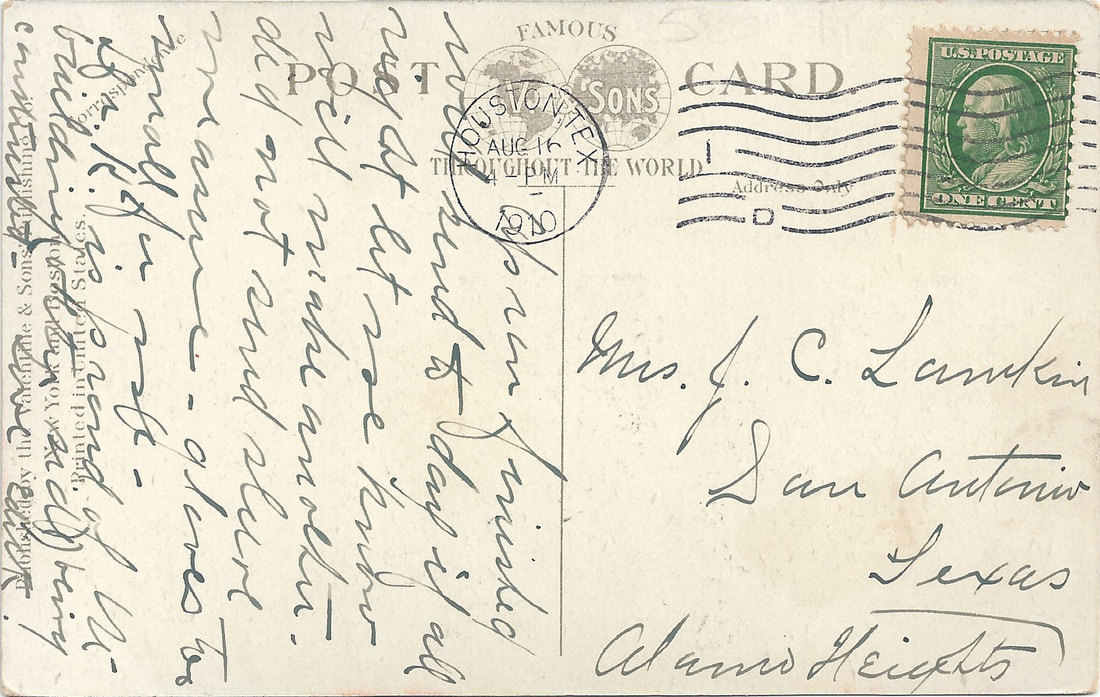Southern Pacific Hospital
|
1910: As the writer of the postcard mentions, the building is still under construction, so the image shown is something of an architectural rendering. It was not fully completed until about a year after the postmark.
|
19 February 2015: From near the corner of Thomas Street at Bishop Street looking west and slightly south. After decades as a hospital for Southern Pacific Railroad employees, the facility became a rehabilitation center for M. D. Anderson Cancer Hospital in the 1970's. In 2001 the building was turned into a hospital for AIDS patients, Thomas Street Health Center., one of the first such clinics in the U. S.
|
|
Postmarked: 16 August 1910 from Houston, Tex.
Stamp: 1c Green Ben Franklin #331 To: Mrs. J. C. Lamkin San Antonio, Texas Alamo Heights From: Edith Message: Apron finished will send to day if all right let me know will make another. did not send sleeve measure - gloves too small for me. Dr. K. Is proud of the building (other side) being constricted - Love Edith ------------------------------------------------ James Caldwell Lamkin was a San Antonio attorney who married Mary House, sister of Edith. The sisters were just two years apart, Mary was born i19 December 1869, and Edith 17 November 1871. They were the oldest children, followed by Cora (1872 - 1891); Ellen (1875); T. W. House, Jr. (1878); James H. (1879). James was born in Luling, Caldwell County, TX, on 5 April 1875, son of Lewis Ab Lamkin (1843-1898) and Mary Eudora. Mary House Lamkin died 14 November 1956; James died 24 February 1964. They are buried in San Jose Burial Ground in San Antonio, TX. ------------------------------------------------ |
In this brief note to her older sister, Edith may sound like a typical housewife of the day, but she was, in fact, something of Houston royalty. Her grandfather had come over from Somerset, England in the 1830’s and fought for Texas Independence. Houston was no more than a village on a muddy bayou then, but here he settled and became a leader in steamboats, banking, and cotton. By 1840 Thomas William House had married Mary Shearn, daughter of Charles Shearn (founder of what became Shearn Methodist Church) and set about becoming arguably the richest man in town. When the Civil War arrived he helped outfit the Houston Light Guard with kid gloves, which became the Kid Glove Gentry. He was mayor during the Civil War as he smuggled cotton to England through the Union blockade in exchange for weapons.
As Edith wrote of aprons and gloves, her Uncle Edward Mandell House was becoming an important figure in Texas politics, seeing to the election of governors at the turn of the century as a behind-the-scenes operator. He would soon turn his attention to national, then international politics as one of the closest confidants of Woodrow Wilson (See Texas State Historical Association). He was instrumental in choosing the original Federal Reserve members, helping in the formulation of the Fourteen Points Peace Program, and working at the Paris Peace Conference of 1919 and in the councils of the League of Nations. But Edith, content with domestic pursuits, even as a 35 year old spinster, still lived in a grand house at 1010 Louisiana (another postcard in this study) with her parents, Thomas William “T.W.” and Ruth Nicholson House, a widowed Aunt, and 3 servants, including James Gaughey, one of the few live-in private gardeners in the city. The house was a city landmark occupying an entire city block between Lamar, Louisiana, Smith and McKinney. Her father would soon become the Houston Postmaster working out of the Post Office on San Jacinto [yet another in this series]. Dr. K was Robert White Knox, chief surgeon of the Sunset Route of the Southern Pacific Railroad and apparently a close family friend. Edith’s mother died in 1914, her father in 1923 and she became the ward of her brother James. Edith died 1 July 1949 and is buried in Glenwood Cemetery in a rather splendid funerary setting surrounded by many House relatives (See Findagrave record for Edith Ruth House). |

